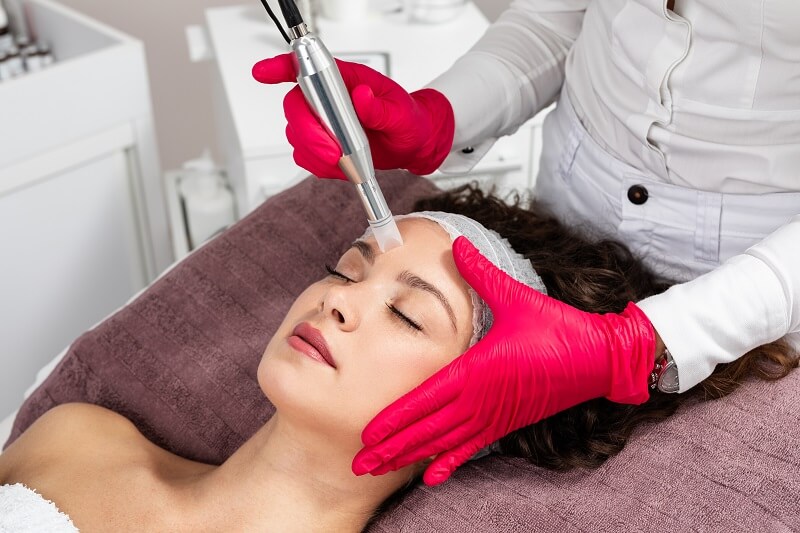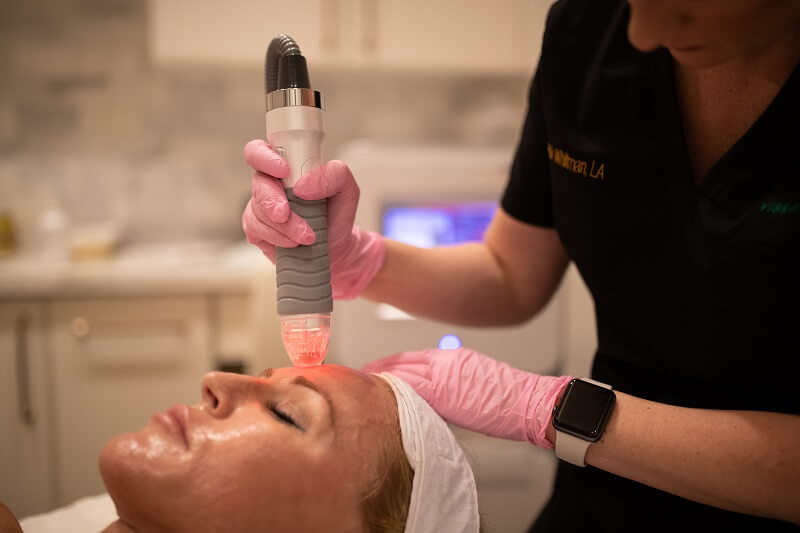Technological advancement has brought new ways to tweak our appearance. People are showing increasing interest in minimally invasive cosmetic treatments because the risks are much lower than with surgery. Microneedling is especially popular because it treats various skin conditions.
Let’s see how microneedling works and what benefits it provides.

What Is Microneedling?
Microneedling is a cosmetic treatment that uses an FDA-approved medical device with small needles to puncture the top layer of the skin. The procedure boosts collagen and elastin production, rebuilding the skin and making it plumper, tighter, and smoother. It can be used on the face, scalp, and body.
Note: Microneedling is commonly used to tighten the skin on the legs and reduce the appearance of cellulite. Learn more about how to tighten the skin on your legs via microneedling and other methods.
How Does Microneedling Work?
The needles in a medical microneedling device make tiny, controlled punctures on the skin’s surface without damaging the epidermis.
The controlled wounds stimulate the body’s natural healing response to injury and increase collagen and elastin production in the deeper layers of the skin. Microneedling creates a new layer of fresh, smoother-looking skin and reduces scars, wrinkles, and blemishes.
Microneedling Benefits
Microneedling improves existing cosmetic issues by stimulating collagen and elastin production and angiogenesis (the formation of new blood vessels from old ones). The resulting benefits of the treatment are:
- Skin tightening
- Wound healing
- Skin rejuvenation
- Tissue remodeling
- Reduced hyperpigmentation and brighter skin
- Enhanced delivery of active ingredients (from creams, serums, drugs) into deeper skin layers
- Reduced acne scars, burn scars, and blemishes
Microneedling can be combined with other treatments, such as PRP therapy (microneedling with PRP, also known as the "vampire facial") or radiofrequency therapy (Vivace microneedling), for enhanced effectiveness and powerful results.
Note: For more information on how microneedling benefits specific areas and skin concerns, refer to our guides:
How to Prepare for Microneedling?
Microneedling providers advise their patients to follow these guidelines before the treatment:
- Avoid exfoliation, laser treatment, and facials for two weeks.
- Stop using acne medications for weeks or months.
- Stop using retinoid products.
- Avoid blood-thinning and anti-inflammatory medications for one week.
- Skip tanning for two weeks.
- Don’t drink coffee or alcohol for 24 hours.
- Avoid fish oil for 48 hours.
- Drink plenty of water for several days.
Microneedling Procedure

The first step of the microneedling treatment is a consultation with your medical practitioner. They will evaluate your eligibility for the treatment. If you’re pregnant or taking certain acne medication, you may not be eligible.
The microneedling specialist first applies topical anesthesia to the treatment area. The cream can take up to one hour to become effective.
The specialist then rolls the microneedling device over the patient’s numbed skin several times in each direction. The device has tiny, short needles that puncture the skin, creating superficial wounds.
Your skincare specialist may apply a serum right after microneedling to utilize your skin’s enhanced receptiveness to rejuvenating ingredients. Post-treatment serums such as PRP, hyaluronic acid, growth factor serum and/or lightening serum enhance the treatment’s effects.
The whole microneedling treatment session may take up to 90 minutes.
Is Microneedling Painful?
Anecdotal evidence suggests that the pain level ranges from completely painless to painful but tolerable. In many cases, patients only feel a mild tingling sensation. The pain level depends on the individual’s threshold and the needle size.
Microneedling Results
Microneedling has a delayed effect because it takes time for the new collagen to form. The results appear gradually three to six months after the final procedure. During that time, you will notice a reduction in wrinkles, scars, and blemishes and an overall improvement in skin tone and texture.
How Long Do Results from Microneedling Last?
The longevity of the results depends on the patient’s unique skin condition and how many sessions they’ve had. They usually last between several months and one year. Some effects of microneedling, such as tightened skin, may last for several years.
How Do You Maintain Microneedling Results?
To maintain the effects of microneedling, patients are advised to properly care for their skin and implement skin-friendly lifestyle habits, including:
- Following a daily skincare regimen.
- Getting enough sleep.
- Avoiding alcohol and inflammatory foods.
- Protecting the skin from UV rays.
Note: The most effective way to protect the skin from UV rays is to wear protective clothing and apply sunscreen vigilantly. Check out our guide on how to choose the best sunscreen for your skin.
Microneedling Aftercare
For the best results, avoid the following products and activities:
- Direct exposure to the sun.
- Strenuous exercise, saunas, and other activities that increase sweating.
- Rubbing and scratching the skin.
- Harsh skincare ingredients and makeup.
- Cosmetic treatments, such as laser, chemical peels, photofacials, etc.
- Excessive alcohol and smoking.
Microneedling Side Effects
No serious risks are associated with microneedling. The procedure is considered safe for people in good health when performed by licensed medical professionals using FDA-approved medical devices.
The most common side effects of microneedling are mild and include redness, bruising, swelling, and inflammation. The side effects usually go away after two or three days but may persist for up to two weeks.
When Should You See a Doctor?
If the side effects are more severe, persist for over a week, or you experience bleeding for more than 24 hours, seek help from your medical provider.
Note: Microneedling does not appeal to you? You'd like to learn about all your options before deciding on a treatment? Find out how microneedling compares to other noninvasive treatments:
- Microneedling vs. Laser
- Microneedling vs. Chemical Peel
- Microneedling vs. Botox
- Microdermabrasion vs. Microneedling
How Much Does Microneedling Cost?
The total price of a microneedling treatment depends on the required number of sessions. At Vibrant Skin Bar, one microneedling session costs $300.
Microneedling at Home: Should You Try It?
Microneedling devices for home use are available. They are less expensive than professional microneedling sessions and save time.
However, at-home derma rollers aren’t as effective as professional treatments. For safety reasons, the DIY devices have shorter needles that don’t penetrate as deeply, so the results are less noticeable. Most at-home devices don’t allow you to change the needles after each session, so the risk of scarring and infection increases.
Even with less invasive needles, the risk of damaging the skin exists. A trained professional knows how to properly switch the needle size depending on the area being treated. At home, you may press the skin too hard and cause more harm than good.
Conclusion
Microneedling is a quick, safe, and often painless way to improve skin issues that don’t respond to topical treatments. It’s important to understand that the treatment provides improvements over time. For the best results, opt for professional microneedling services performed by experienced medical practitioners.
Next, find out if microneedling and Botox can be used together, and who is a good candidate for this combination.


